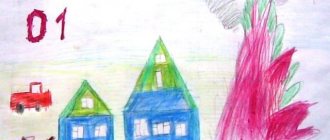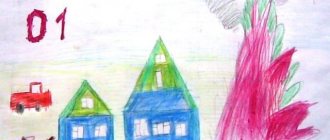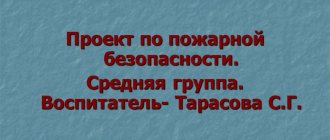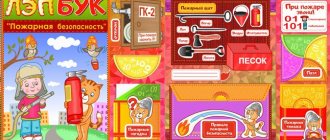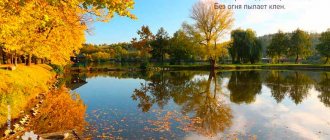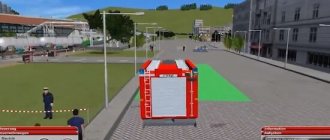ALL-RUSSIAN CREATIVE COMPETITION on PPB WITH INTERNATIONAL PARTICIPATION “CAUTION, FIRE” Complies with Federal State Educational Standards
CONTEST REGULATIONS
on the website of the Internet portal “Children are the flowers of life”
Certificate of registration of mass media in Roskomnadzor: EL No. FS77-64892
Deadlines for the competition: CONTINUALLY Competition results FOR THE NEXT DAY The results page is periodically updated
Children are the most vulnerable to fire; they can range from toddlers to schoolchildren. With the help of a creative competition, children will talk about the possible causes of a fire and how to prevent it. This competition will help develop speech, the ability to write stories, and communicate with peers. Develops respect for the firefighting profession.
Competition participants The competition is held for educational institutions of any type and type from any country. Pupils of any preschool institutions from any country. Students of grades 1-11 of schools, lyceums, gymnasiums, colleges and other educational institutions. Children not attending educational institutions. Teachers, educators, senior educators, music workers, physical education workers, visual arts specialists, speech therapists, speech pathologists, parents, grandparents. Anyone who wants.
Nominations: “Drawing”; "Application"; “Decorative and applied creativity”; “Craft from Lego constructor; “Corner on PPB”; "Presentation"; “Video” “Perspective Plan”; "Project"; "Note of GCD"; “Lesson summary”; "Extracurricular Hour"; "Entertainment Script"; "Methodological development"; "Literary creativity"; “Stands, posters, memos, booklets on PPB”; “Consultations for parents”; "Wall newspaper"; "Photo"; "Lapbook"; “Free nomination” - on the theme of the competition
Evaluation criteria: Good image quality. Good design quality. Reflection of the theme through an artistic image. Artistic and creative skills. Originality, expressiveness. Relevance to the topic. jpg extension. There are no restrictions on first places.
Conditions of the competition: 1. You can take part in several categories. Each competitive entry is paid separately; 2. Each work must have a title and contain an accompanying inscription in the application indicating the surname, first name and age of the child (the teacher should write his initials in full, do not indicate age); 3. The work must be copyrighted (in the case of sending someone else’s work to the competition under one’s own name, the participant himself bears responsibility for copyright infringement). 4. Drawings can be made by any means: pencil, pen, gouache, oil; painting, computer graphics, drawings made on paper, sand, asphalt; 5. Send text documents only in Word format. Photos in JPEG format 6. Presentation, video, scripts, notes, etc. can be presented jointly with co-authors. An registration fee must be paid for each co-author. Each co-author receives a separate diploma. Video filming can be done with a video camera or done using a cell phone. Images must be clear and of high quality. Sound without interference. 7. Competitive works of children of different ages are evaluated separately, prizes are determined in each age category. 8. There are no restrictions on first places.
How to participate: 1. Pay the registration fee for the competition in the payment form. 2. Fill out the application to participate in the competition. Application for competitions and quizzes. The application contains one participant and one curator. Collective applications (without listing names) with only one curator are accepted. For each co-author or second curator, an additional 50 rubles are paid. You can pay with one check. The co-author or second curator receives a separate Diploma in his/her name. 3. If you need a Curator Certificate, then pay an organizational fee of 50 rubles for obtaining a Curator Certificate and fill out an application for a curator. Application for a supervisor certificate. 4. Without payment for the registration of the Diploma to the competition participant, the Certificate will not be issued to the curator. We issue a free Curator Certificate only for 5 or more competition participants. How to submit your work: 1. Sign the competition work with the participant’s last name. (Ivanov, Petrov) 2. Sign the application with the participant’s last name and attach it to the letter in Word format. 3. Receipt (scan or jpg). attach as a separate file. In case of an error made when filling out the application, corrections in diplomas will be made for an additional fee (50 rubles). We correct our mistakes free of charge. All Diplomas are sent to your E-mail specified in the application. 4. Attach separate files to one letter: - application; — check — (indicate for whom the payment was made); — competition work or a link to the competition work. Applications and competition entries that do not meet the requirements of this provision will not be accepted or considered. 5. Send an email. email [email protected] Please indicate the name of the competition in the subject line of the email. If you do not receive the Diploma after 1 day, resend the letter. After summing up the results, Winner Diplomas are sent out free of charge. Curators will receive a Curator Certificate only after issuing a Diploma to the participant and paying the registration fee for issuing a Curator Certificate. WE WISH YOU VICTORY IN THE COMPETITION! If you notice a typo or discrepancy in the application in the Diploma, send a repeat of the application and correctly indicate what should be changed for what.
Fire safety quest game “You may not be a firefighter, but you must know the rules”
Quest game for fire safety stations “You may not be a firefighter, but you must know the rules”
Target:
consolidating students' knowledge about fire safety through games.
Objectives:
1. consolidate knowledge about fire safety rules;
2.develop a sense of collectivism and mutual assistance; 3.organization of leisure activities for children. Preparatory work:
students are divided into the number of teams according to the number of stations (I have 10);
teams are formed as follows: in each team there are students from grades 1 to 11 (1, 2 students). The game was played outside. Preliminary work:
route sheets are prepared, a trained adult stands at each station.
Necessary equipment:
a barrel with markings, buckets, a fire safety poster, clothing (jacket, helmet, mittens, etc. at the conductor’s choice), an envelope with a cut picture;
medical equipment (if possible). Progress of the event: 1. Team building.
2.Introductory remarks. We say – fire is our friend!
But he will suddenly become an enemy, If we forget about him, He will immediately take revenge on people. You will regret it in the battle with fire. Here he is scary and harsh - And there is a lot of firewood from the house. - Guys, all of you have probably seen more than once how red cars rush through the city, blocking the smooth noise of the streets with alarm signals. This means that there is a fire somewhere and someone needs immediate help. And how often on TV they show fires occurring in different parts of the country. Usually you listen to all this and think that this does not apply to you personally. And yet, the number of fires is increasing. Now we will check and consolidate our knowledge about fire safety. Please choose captains! 3Explanation of the rules of the game.
-You must be friendly, fast, dexterous and smart to win!
But that doesn't mean you should rush! Good luck everyone! The guys start moving in accordance with the route sheets. 1st station “How to put out a fire.”
Students are asked to list all the fire extinguishing means they know (water, foam, snow, earth, sand, carbon dioxide, fire extinguishers, etc.).
For each answer 1 point. Then the team is offered an envelope containing a cut-out illustration of an item related to fire safety. Teams must create this image and name it. Then each team member must tell them how to use it. The correctness and accuracy of execution is assessed. (For example, a fire extinguisher.) Station 2 “How to provide first aid to a person who has received a thermal burn.”
The guys answer the question, applying the acquired knowledge in the lessons.
They start with the younger kids. You can offer to choose the necessary medications and instruments needed in this case (syringe, scissors, bandage, cotton wool, nasal drops, mustard plasters, brilliant green, cream (whatever is available). In theory, the guys should choose practically nothing. Then the adult at the station summarizes the children's answers: There are four degrees of burn: 1 - redness of the skin, swelling; 2 - the appearance of blisters; 3 - a scab forms at the burn site; 4 - charring of the tissue. First aid is provided only for the first degree of burn. It is necessary immediately treat with a clean soft cloth moistened with alcohol to disinfect and reduce pain. Subsequently, a bandage with furatsilin can be applied to the affected area. Burns of other degrees are not treated, they are protected with a dry sterile bandage. Do not use fat or petroleum jelly for burns, as well as solutions of potassium permanganate and "green marks", which make it difficult to recognize the severity of the burn. Work at the station is assessed on a 5-point system. 3 station "Water carriers".
- Guys, remember what the sign that indicates a fire-fighting reservoir looks like?
— Where on the territory of our camp are these signs located? -What is most often used to put out fires? (Water). — How should firefighters work? (Clearly, harmoniously). - Now you will fill the barrel with water, to do this you must line up in a chain and pass the bucket to each other! You are given 3 minutes to complete the work. Think about how it is more convenient for you to stand up, who will do what. (On the barrel there is a marking of the volume of water, the number and size of buckets at the choice of the person conducting the event). The sheets indicate the amount of water collected and how accurately the guys worked. Station 4 “It’s not a riddle without a answer”
The presenter reads riddles to each team.
For the correct answer 1 point. The red cow ate all the straw. (Fire.) In a small barn there is a fire on fire. (Matchbox and matches.) Bury it - it won’t rot, throw it in water - it will float. (Coal.) The red bull stands, trembles, the black one runs to the sky. (Fire and smoke.) Small, remote, but brings big trouble. (Spark.) I come from fire, and from fire I die. (Coal.) There is a house with fifty sisters in it. I would advise the children, don’t play with the house with this! (Matchbox.) No matter how much you eat, you will never be full. (Fire.) Station 5 “Motto of the fire department.”
Each team is given a separate sheet with incomplete mottos.
The children are asked to add lines to the motto. Evaluated when summing up results. • ……………………………………………………….. That you can’t joke with fire! • Easier than putting out a fire, ……………………………………………………. 6th station “Question - answer”
The presenter asks questions, for the correct answer - a card, points are assigned according to the number of cards earned.
Questions: 1. Which organ is protected by a cotton-gauze bandage during a fire? (Breathing.) 2. Burn caused by flame, boiling water, steam, or touching hot metal objects. (Thermal) 3. Fire extinguishing agent. (Fire extinguisher.) 4. What exit should be sought during evacuation in case of fire in a store, cinema and other public places? (Emergency.) 5. Fire department number? (01.) Children must also remember the number to call the car from a cell phone! 6. Why is the fire department telephone number 01? • 01 – simple, everyone will remember it, • 01 – short number, every minute counts in a fire, • 01 – convenient number, easy to dial in the dark on the telephone dial. 4. What should you do if smoke comes out of a working TV or some other electrical appliance? Answer: I'll unplug it and throw a damp blanket over the TV. 5. What should not be done to extinguish live electrical wiring? Why? Answer: You cannot extinguish with water and foam fire extinguishers, since water is a conductor of electric current. 6. What to do if gasoline spilled near the garage caught fire? Answer: I will put out the fire with sand or earth. Station 7 “The most attentive”
A) The guys are asked questions for their attention: -Where are the fire extinguishers in our building?
— Where is the fire control panel located in the building of the country base? — Where is the evacuation plan? Etc. B) Select captions for the posters. The children are offered a poster with fire safety rules. It is suggested to select captions under the pictures. (The poster is familiar to the guys; it hangs at the entrance to the camp building). Correctness of answers is assessed - 1 point. Station 8 “Dress the fireman.”
Two chairs (benches, stumps on the court), the team stands at one chair, the captain at the other.
On the chair there is a jacket, mittens, a helmet, a hose (skipping rope, gymnastic stick). Each child runs up to the captain, the captain dresses the child, he takes the hose, runs around the chair, and undresses. Passes the baton to a friend. This is how all children pass the relay race. The passage time and calmness in actions are taken into account. After passing, the presenter makes a conclusion with the guys that everything needs to be done clearly, consistently, without fuss. 9 station “Select action”.
What should you do if a person finds himself in a fire zone and his clothes catch fire?
Your actions are in order. Explain what they are based on. The children are given time to think and prepare an answer. Answer: You can’t run around in burning clothes; this only makes the flames worse. If a small area is on fire, remove clothing and extinguish it away from flammable objects. When the flame covers most of the clothing, first of all, you need to take a horizontal position so that the fire does not spread to the head, and then extinguish it with water, snow, sand, liquid mud, fire extinguishing powder, you can even use a foam fire extinguisher. The victim must close his eyes. Station 10 "Black Box".
The presenter shows a black box containing an item related to fire safety.
Each team takes turns asking questions about the contents of the box. The presenter can only answer “yes”, “no”, “hot”, “cold”. Evaluated on a 5-point system, guesses the item in a shorter time. (Iron.) After counting the points and discussing the progress of the game, the results are summed up.
Prizes and diplomas for winners and participants. Host: Guys, always remember that it is easier to prevent a fire than to put it out, that a small match can turn into a big disaster. To avoid a fire, you must know and strictly follow fire safety rules. But if a fire does occur, you need to clearly know how to behave. Try to let fire always be your friend and never become your enemy. Protect your life, the lives of other people, the house you live in, and the school you study at from fire!
Drawings on the topic of fire safety.
Pencil drawing “A fireman extinguishes a fire in a house”
Drawing a fireman is quite a challenging task for preschoolers of any age. But if you do this step by step, the child will easily cope with the task. Where to start and how to draw the details can be seen in the drawings, but an adult will explain much better with his own example. All that remains is to finish drawing the fire in the house and color the drawing.
Everything that the child was told in kindergarten about fire safety, he will remember if these lessons were reinforced with creativity. DIY crafts will help your child learn information. This knowledge will be strengthened and expanded at school. In the meantime, the kindergartener can draw, sculpt and glue, learning the basics of his safety.
